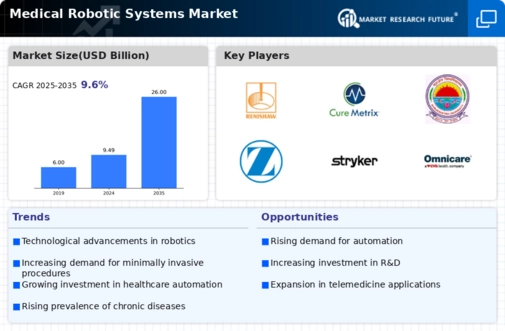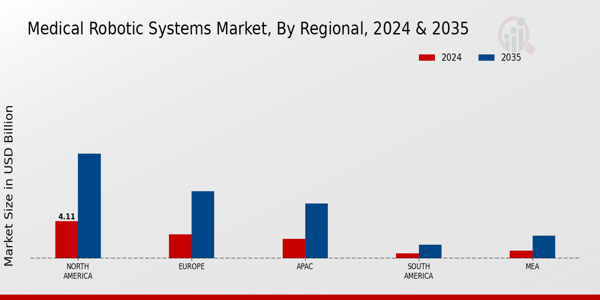Aging Population
The aging global population is a critical driver of the Global Medical Robotic Systems Market Industry. As individuals age, they often require more medical interventions, including surgeries that can benefit from robotic assistance. The World Health Organization indicates that the number of people aged 60 and older is expected to double from 12 percent to 22 percent of the global population by 2050. This demographic shift is likely to increase the demand for robotic systems in various medical applications, thereby propelling market growth and innovation in robotic technologies.
Market Growth Projections
The Global Medical Robotic Systems Market Industry is poised for substantial growth, with projections indicating a market value of 9.49 USD Billion in 2024 and an anticipated increase to 26 USD Billion by 2035. This growth trajectory suggests a compound annual growth rate of 9.6 percent from 2025 to 2035, reflecting the increasing integration of robotic systems in healthcare. The market dynamics are influenced by various factors, including technological advancements, demographic shifts, and rising healthcare expenditures, all contributing to a robust expansion of the industry.
Technological Advancements
The Global Medical Robotic Systems Market Industry is experiencing rapid technological advancements, which are enhancing the capabilities of robotic systems in healthcare. Innovations such as artificial intelligence, machine learning, and advanced imaging techniques are being integrated into robotic systems, improving surgical precision and patient outcomes. For instance, robotic-assisted surgeries have shown a reduction in recovery times and complications. As a result, the market is projected to reach 9.49 USD Billion in 2024, with these advancements driving demand for more sophisticated robotic solutions.
Rising Healthcare Expenditure
Increased healthcare expenditure across various regions is significantly impacting the Global Medical Robotic Systems Market Industry. Governments and private sectors are investing more in advanced medical technologies to improve healthcare delivery and patient outcomes. For example, countries are allocating substantial budgets to upgrade healthcare infrastructure, which includes the procurement of robotic systems. This trend is expected to sustain a compound annual growth rate of 9.6 percent from 2025 to 2035, indicating a strong commitment to integrating robotic solutions into healthcare systems.
Enhanced Training and Education Programs
The establishment of enhanced training and education programs for healthcare professionals is fostering the growth of the Global Medical Robotic Systems Market Industry. As robotic systems become more prevalent in surgical settings, there is a corresponding need for skilled personnel who can operate these advanced technologies. Medical institutions are increasingly incorporating robotic training into their curricula, ensuring that new surgeons are well-versed in robotic-assisted techniques. This focus on education is likely to facilitate the adoption of robotic systems, thereby contributing to the overall market expansion.
Increasing Demand for Minimally Invasive Surgery
There is a growing preference for minimally invasive surgical procedures among patients and healthcare providers, significantly influencing the Global Medical Robotic Systems Market Industry. These procedures typically result in shorter hospital stays, reduced pain, and quicker recovery times. Robotic systems facilitate such surgeries by providing enhanced dexterity and precision. The increasing adoption of robotic-assisted surgeries is expected to contribute to the market's growth, with projections indicating a rise to 26 USD Billion by 2035, reflecting a robust shift towards advanced surgical techniques.












